Final report for OW23-382
Project Information
Soil acidification negatively impacts the potential yield and quality of agronomic crops, decreases plant available nutrients in the soil, and increases weed and disease pressure. While most arable farmland in eastern Idaho has high pH testing soils, soil acidity is becoming increasingly problematic in eastern Idaho, especially in Fremont, Caribou, Bonneville, and Oneida counties. Precipitated calcium carbonate (PCC), a by-product derived from the sugar beet sugar purification process, is a readily available lime source to remediate acidic soils in eastern Idaho. This project will address the needs of eastern Idaho producers by conducting on-farm, variable PCC rate strip trials and annually monitoring changes in crop yield, weed presence, and soil pH at multiple soil depths over three years. This project will also evaluate the DualEM electrical conductivity sensor to map changes in soil texture across a field and develop variable-rate PCC prescriptions. Education and outreach about soil acidity, its impacts on agriculture, liming materials, and how lime rate prescriptions are made will be done through annual field days; outreach materials including newspaper, TV, and radio stories; presentations at producer and professional meetings; and Extension bulletins and journal articles. We expect this project to benefit 160,000 acres of acidifying soils in eastern Idaho, and to be of value to producers in northern Idaho and other western states. We anticipate this project to have 400 direct contacts and more than 11,000 indirect contacts annually.
- Conduct on-farm field trials to remediate acidic soils using precipitated calcium carbonate in eastern Idaho (September 2023 – August 2026).
- Provide agricultural stakeholders with information regarding liming for acidic soil remediation and weed control through direct engagement at field days and workshops and indirect contacts including newspaper articles and Extension bulletins (September 2024 – August 2026).
The first four major milestones associated with Objective 1 is fall soil sampling before (2023) and after (2024, 2025, 2026) applying PCC to each field site. These measurements will provide baseline information about each field and allow us to track changes in soil pH due to PCC applications and field management. Additional milestones for Objective 1 include collecting and analyzing yield data from each georeferenced point within each treatment strip in August for small grains and June and August of 2024, 2025, and 2026 for alfalfa. This data is critical for the study because it will inform us of the economical (dis)advantage gained from applying PCC.
For Objective 2, annual summer field days will be held in July 2024, 2025, and 2026. The field days are prime opportunities to disseminate information about acid soils and PCC as a soil amendment to a diverse audience. Further, the general populace has an opportunity to observe treatment differences and ask questions. One (2023, 2024) or two (2025) Extension bulletins will be developed and published each fall to early winter and distributed at subsequent field days. The final milestone of drafting and publishing one or more journal articles and the project dataset will occur during the summer of 2026.
Cooperators
- - Producer
- - Producer
- - Producer
- - Producer
- - Technical Advisor (Educator and Researcher)
- - Producer
Research
Objective 1: Conduct on-farm field trials to remediate acidic soils using precipitated calcium carbonate in eastern Idaho (September 2023 – August 2026)
On-farm field scale strip trials were conducted and maintained in Fremont County (one location) and Caribou County (two locations) from 2023 to 2026 on acidic soils (pH <5.5). Selected field sites have not received lime applications within five years of study initiation and will have a soil surface pH ≤5.6. The typical crop rotation of these regions was small grains (either barley or wheat) rotated with alfalfa. The field sites were tilled (typical of regional management practices) to incorporate the lime because these locations have high elevations (e.g., 5200–6200’ above sea level) with cool, short growing seasons. Selected field sites were planted into small grains during the 2023 growing season to ensure that the lime could be incorporated into the soil with tillage.
Lime application treatments consisted of four rates of PCC applied at 0, 2, 4, and 6 "as applied" tons per acre with four replications. These rates encompass the lime application rates reported by producers in Fremont County. The individual strips were long (e.g., 450’) and narrow (e.g., 50’) to capture natural variation across the field and to match the width of a commercial applicator’s spreader.
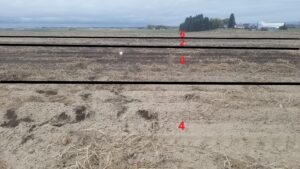
To verify the applied PCC lime rate, we placed disposable 9" diameter plates every 112’ along the center of each strip (3 plates per strip). The mass of PCC collected in each pan was divided by the surface area of the plate and converted to tons per acre. PCC was obtained from Amalgamated Sugar Company and was applied from September to October 2023. Other than liming, the strip trials were managed according to each producer’s individual practices including method and depth of lime incorporation, crop rotation, and harvest timing.
Soil samples were collected from a 112’ x 50’ georeferenced grid soil sampling pattern (~0.38-acre grid) at 0-2, 2-4, 4-6, and 6-12” depths in September to October of 2023 before liming and again in 2024. These soil samples were dried, ground, homogenized, and analyzed for soil pH1:1 (soil: water) (method S-2.20; Gavlak et al., 2005), electrical conductivity (method S-2.30; Gavlak et al., 2005), and free lime if the soil pH>7. Each fall, additional soil samples were collected at 0-6” and 6-12" depths and analyzed for extractable aluminum (a source of soil acidity and root toxicity; method S-15.10; Gavlak et al., 2005).
We will map the study area for soil electrical conductivity using an EM38 electrical conductivity sensor in 2025. Each pass of the sensor will be spaced 25’ to 30’ to provide a high spatial resolution of changes in soil electrical conductivity. Soil electrical conductivity is well correlated to soil texture. This map, combined with a topography map and our grid-sampled soil pH measurements, was used to explore the feasibility of developing variable-lime-rate maps (Cossel et al., 2019). ArcGIS will be used to map each layer and explore ordinary kriging, inverse distance weighting, and radial base function statistical analyses to interpolate soil pH and electrical conductivity measurements to the rest of the study area (Zandi et al., 2011). If successful, this will allow producers to potentially save money by adjusting their lime rates to match the soil requirements instead of applying a blanket lime application.
Our collaborating producers have noted that certain weeds, such as corn spurry and barnyard grass, thrive in low pH conditions. Due to tillage before liming, we were unable to document (photograph, record weed biomass and/or plant count per square foot, weed species) and georeference regions of the field where significant weed patches (≥100 square feet) were prevalent. Weed patches will be monitored each field for changes in weed pressure, species, and patch sizes.
In years when small grain crops will be grown, we will collect the following information from each georeferenced point: stand counts and visual differences in color or development at Feekes 2–3, evidence of root deformity or stunting (evidence of aluminum toxicity), heading date, maturity date, number of kernels per head, and number of stems per plant. Yield will be measured in each plot with a plot combine by harvesting four 5’ by 100’ strips from the center of each strip plot. Yield components (test weight, grain protein) will be evaluated on a grain subsample from each 5’ by 100’ strip. Straw yield will be estimated by collecting 5’ of windrow from the center of each 100’ long strip. Nutrient removal in the grain and straw will be estimated by collecting a representative grain and straw sample from each georeferenced point and analyzing it for macro- and micronutrient content.
To ensure that the data we collected will be available for future research, we utilized the USDA Fertilizer Recommendation Support Tool minimum data set (Slaton et al., 2021) to record information about the field sites, management practices, and data results. At the completion of the study, the data set will be published at Ag Data Commons to allow other researchers access to our raw data.
In the fall of 2023, Dr. Spackman, Tom Jacobsen, and Jared Gibbons worked with cooperating producers to identify several potential field sites for the new studies. Using a portable pH probe and a GPS, they mapped the surface soil pH of several fields. Five fields were selected that exhibited surface soil pH values <5.6. Three fields were used for this Western SARE project and two fields were utilized for a companion study funded by the Idaho Barley Commission. The fields exhibited significant variation in soil pH, potentially due to water movement, topography, and changes in soil texture. These field sites were selected in hopes that they would prove successful candidates for generating variable lime rate prescription maps.
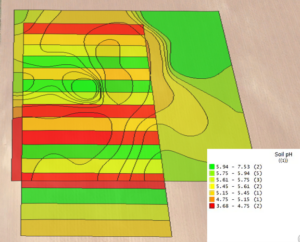
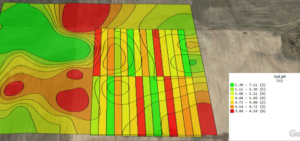
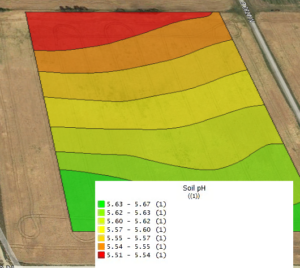
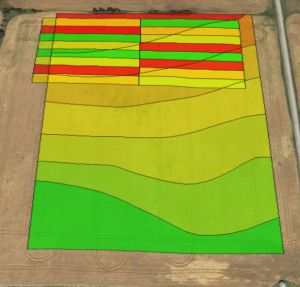
PCC was shipped to each site from the Amalgamated Sugar beet processing plant in Paul, Idaho. Ten subsamples were collected and composited from each PCC shipment and analyzed for calcium carbonate equivalent, moisture, nutrient content, pH, and salt content (Table 1). Unlike agricultural lime or other lime products, PCC is not a pure lime product. It contains impurities such as dirt, organic matter, water, and nutrients. The PCC used in this study had a calcium carbonate equivalent of 67-73% on a dry basis, or 46-60% as applied. Therefore, a 4-ton per acre application of PCC (as is) was equivalent to 1.8-2.4 tons per acre of agricultural lime. In addition to lime, each ton of PCC supplied approximately 5-7 pounds of total nitrogen (N), 19-27 pounds of phosphorus (P2O5), 0.3-3 pounds of potassium (K2O), 408-491 pounds of calcium (Ca), 14-18 pounds of magnesium (Mg), 8-10 pounds of sulfur (S), and 2 pounds of iron.
Table 1. Measured physical and chemical properties of the precipitated calcium carbonate used at the three field sites in Soda Springs and Lamont, Idaho.
| Soda Springs 1, Idaho | Soda Spring 2, Idaho | Lamont, Idaho | |
| Calcium carbonate equivalent %, on an as received basis | 54.9 | 46.9 | 60.2 |
| Dry matter % | 75 | 64.8 | 81.8 |
| Dry matter, lb/ton as received basis | 1500 | 1296 | 1636 |
| Total N, lb/ton as received basis | 6 | 4.8 | 6.87 |
| Total Carbon, lb/ton as received basis | 159 | 160.06 | 213.5 |
| C:N Ratio, Dry wt. basis % | 26.5:1 | 33.3:1 | 31.1:1 |
| Nitrate-N, lb/ton as received basis | 0.02 | 0.03 | 0.01 |
| P2O5, lb/ton as received basis | 25.65 | 20.61 | 27.32 |
| K2O, lb/ton as received basis | 3.3 | 1.43 | 0.33 |
| Calcium, lb/ton as received basis | 471.75 | 407.98 | 491.13 |
| Magnesium, lb/ton as received basis | 16.65 | 14.26 | 18.16 |
| Sulfur, lb/ton as received basis | 9.9 | 7.91 | 10.47 |
| Zinc, lb/ton as received basis | 0.056 | 0.012 | 0.023 |
| Iron, lb/ton as received basis | 2.193 | 1.818 | 2.336 |
| Manganese, lb/ton as received basis | 0.266 | 0.226 | 0.28 |
| Copper, lb/ton as received basis | 0.011 | 0.104 | 0.005 |
| Boron, lb/ton as received basis | 0.011 | 0.003 | 0.002 |
| Sodium,lb/ton as received basis | 0.96 | 0.87 | 1.15 |
| P, lb/ton as received basis | 11.3 | 9.1 | 12 |
| K, lb/ton as received basis | 2.7 | 1.2 | 0.3 |
| pH, as received, Dry wt. basis % | 8.7 | 8.9 | 8.7 |
| Salts as EC, mmhos/cm, Dry wt. basis % | 0.7 | 0.7 | 2 |
A total of 576 soil samples were collected in the fall of 2023 from the three field sites. These soil samples have been dried, ground and are currently being analyzed for soil pH (1:1 soil:water) and electrical conductivity.
During the 2024 growing season, each field was planted to malt barley. Weed patches were minimal due to effective herbicide control. We will continue to monitor each field for changes in weed pressure, species, and patch sizes.
Several hailstorms passed through Soda Springs Field 1 at late heading through drydown that completely defoliated the field and knocked all grain from the heads. The farmer collaborator at Soda Springs Field 2 was unable to plant spring barley in a timely fashion in the spring. The barley was hit with a killing frost at flowering and there were no viable heads throughout the entire field. We were unable to harvest either field in Soda Springs or to take any yield estimates. We were able to collect yield estimates from the Lamont field by cutting three 100' x 5' sections from within each strip plot. In the first year since lime application, lime applications did not significantly impact yield. This result is similar to other results reported in Montana, the Midwest US and Australia.
Soil samples were taken from each field in late September at depths of 0–2, 2–4, 4–6, and 6–12 inches and analyzed for pH (1:1 soil-to-water), electrical conductivity, and free lime (for pH >7). Additional samples from 0–6 inches were analyzed for KCl extractable aluminum, a contributor to soil acidity and root toxicity.
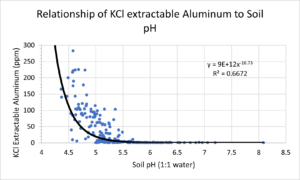
As noted earlier, soil samples were collected from 48 georeferenced points both at planting and again in the fall after harvest in 2024. Samples were taken at depths of 0-2”, 2-4”, 4-6”, 0-6”, and 6-12”. When averaged across all five locations, the greatest change in soil pH from 2023 to 2024 occurred at the 0-2” depth. For every ton of PCC applied, the soil pH increased by 0.28 units at this depth. At deeper sampling depths, the rate of pH change was smaller, with increases of 0.07, 0, 0.18, and 0.04 units per ton of PCC at the 2-4”, 4-6”, 0-6”, and 6-12” depths, respectively. This pattern aligns with the fact that the PCC was surface-applied and either incorporated or not incorporated using various tillage implements at different depths.
Research Outcomes
There can be significant variation of soil pH values measured across a field and by depth within a soil profile. Previous results from our lab have indicated that the soil pH of eastern Idaho soils increases with depth, indicating that these soils are likely acidifying due to historic agricultural management practices. Fertilizers are typically applied in the top 6" of the soil profile. Ammonia-based and elemental sulfur fertilizers acidify the soil as they are nitrified or mineralized. Soil sampling depth may mask potential acidity issues in a field. Because the deeper subsoils are likely more alkaline than surface soils, collecting soil samples to 1', as is common in southern Idaho, may fail to capture acidic soil issues. When soil acidification is a potential concern it may be advisable to collect soil samples to 6" for more timely remediation of acidity issues.
When considering liming as an amendment for acidic agricultural fields, it is useful to understand spatial variation across a field. This may be accomplished through grid or zone sampling. This research has indicated that soil pH may vary with topography. For example, the Lamont field site soils were more acidic soils on the toeslope and became increasingly alkaline moving up the hillslope to the hilltop. Soda Springs 1 and Soda Springs 2 tended to have more acidic soils in the rills between hillslopes where surface and subsurface runoff was most likely to leach and remove base cations.
Education and Outreach
Participation Summary:
We intend to use field days, crop schools, Extension bulletins, journal articles, and newspaper and magazine articles to disseminate educational information about soil acidity, liming, and our project results. To encourage participation at cereal schools, we advertised upcoming events and conferences on the University of Idaho calendar, by emailing growers and crop advisors, posting flyers at local businesses and gathering places, phone calls, and our day-to-day interactions with stakeholders.
As of March 2025, information from this study has been shared at the 2023 Western Alfalfa and Forage Symposium: Soil Fertility and Health Workshop, two cereal schools held in Soda Springs and St. Anthony, Idaho in February 2024, grower field days in Soda Springs and Ashton in July 2024, and the East Idaho Cereals Conference in February 2025. These presentations directly taught 184 growers, crop advisors, industry representatives, and university Extension educators and researchers. At each of these events, we included images detailing the impact of soil acidity on crop production giving real-world examples of how liming remediated soil acidity and improved crop productivity.
We met with each participating grower individually when applying the precipitated calcium carbonate. During these meetings, we had detailed discussions about the study and the effects we expected to see in the on-farm trials. For these trials, we specifically chose areas of their fields with low or variable soil pH levels. We also shared soil pH maps with them and talked about how past practices like tillage and fertilizer use might have contributed to their current soil acidity issues. In December 2024, we met again to review the results of their field studies. Each grower was very involved and particularly interested in understanding how liming affected their soil pH and how deep the soil remediation went.
Education and Outreach Outcomes
It is important to closely coordinate our educational events with other agricultural education suppliers, such as local coops and ag dealers. Several of our cereal schools, while well advertised, were not attended as well as we had hoped because other groups were holding their grower meetings on the same day. For example, Valley Wide held a grower meeting in St Anthony on the same day we held our cereal school in 2023. Several growers and Valley Wide crop consultants expressed a desire to attend our cereal school but were obligated to attend the Valley Wide meeting. To remedy this, we have already selected the dates for the 2025 cereal schools and have begun sharing the dates with the local coops and ag dealers so we don't schedule our meetings on top of one another.
Soil pH
optimum Soil pH ranges for crops
Effect of liming on soil pH
Selecting the appropriate lime rate